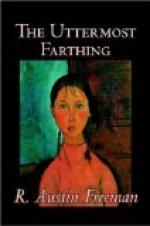“I remained awake a long time cogitating on the situation. Was the man whom I had captured the right man? Had I accomplished my task, and was I now at liberty to ‘determine,’ as the lawyers say, the lease of my ruined life? That was a question which the morning light would answer; and meanwhile one thing was clear: I had fairly committed myself to the disposal of the dead burglar. I could not produce the body now; I should have to get rid of it as best I could.
“Of course, the problem presented no difficulty. There was a fire-clay furnace in the laboratory in which I had been accustomed to consume the bulky refuse of my preparations. A hundredweight or so of anthracite would turn the body into undistinguishable ash; and yet—well, it seemed a wasteful thing to do. I have always been rather opposed to cremation, to the wanton destruction of valuable anatomical material. And now I was actually proposing, myself, to practice that which I had so strongly deprecated. I reflected. Here was a specimen delivered at my very door, nay, into the very precincts of my laboratory. Why should I destroy it? Could I not turn it to some useful account in the advancement of science?
“I turned this question over at length. Here was a specimen. But a specimen of what? I am no mere curio-monger, no collector of frivolous and unmeaning trifles. A specimen must illustrate some truth. Now what truth did this specimen illustrate? The question, thus stated, brought forth its own answer in a flash.
“Criminal anthropology is practically an unillustrated science. A few paltry photographs, a few mouldering skulls of forgotten delinquents (such as that of Charlotte Corday), form the entire material on which criminal anthropologists base their unsatisfactory generalizations. But here was a really authentic specimen with a traceable life-history. It ought not to be lost to science. And it should not be.
“Presently my thoughts took a new turn. I had been deeply interested in the account that I had read of the ingenious method by which the Mundurucus used to preserve the heads of their slain enemies. The book was unfortunately still in the museum, but I had read the account through, and now recalled it. The Mundurucu warrior, when he had killed an enemy, cut off his head with a broad bamboo knife and proceeded to preserve it thus: First he soaked it for a time in some non-oxidizable vegetable oil; then he extracted the bone and the bulk of the muscles somewhat as a bird-stuffer extracts the body from the skin. He then filled up the cavity with hot pebbles and hung the preparation up to dry.
“By repeating the latter process many times, a gradual and symmetrical shrinkage was produced until the head had dwindled to the size of a man’s fist or even smaller, leaving the features, however, practically unaltered. Finally he decorated the little head with bright-colored feathers—the Mundurucus were very clever at feather work—and fastened the lips together with a string, by which the head was suspended from the eaves of his hut or from the beams of the council house.




